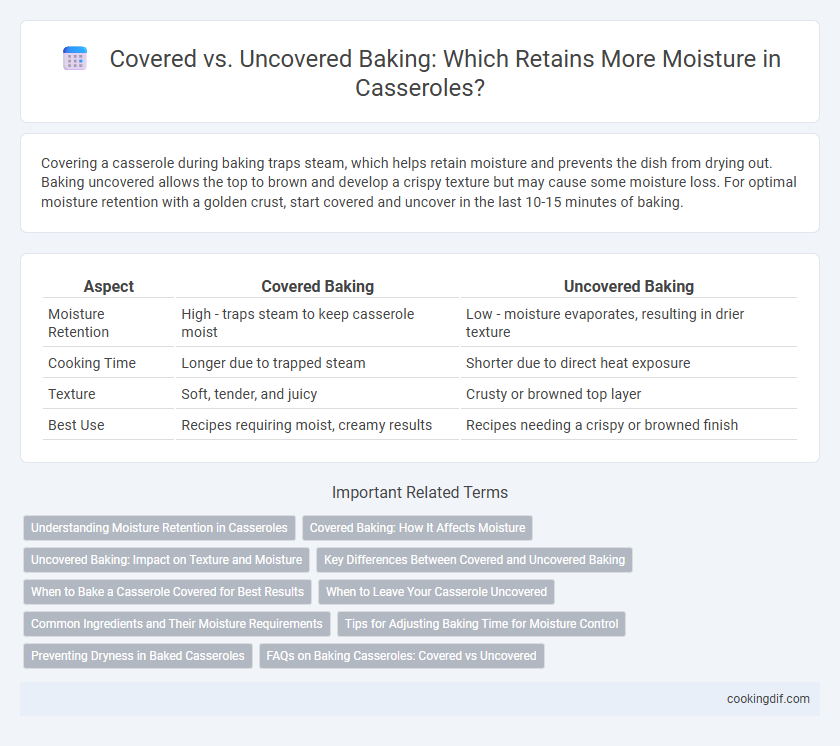Covering a casserole during baking traps steam, which helps retain moisture and prevents the dish from drying out. Baking uncovered allows the top to brown and develop a crispy texture but may cause some moisture loss. For optimal moisture retention with a golden crust, start covered and uncover in the last 10-15 minutes of baking.
Table of Comparison
| Aspect | Covered Baking | Uncovered Baking |
|---|---|---|
| Moisture Retention | High - traps steam to keep casserole moist | Low - moisture evaporates, resulting in drier texture |
| Cooking Time | Longer due to trapped steam | Shorter due to direct heat exposure |
| Texture | Soft, tender, and juicy | Crusty or browned top layer |
| Best Use | Recipes requiring moist, creamy results | Recipes needing a crispy or browned finish |
Understanding Moisture Retention in Casseroles
Baking casseroles covered traps steam, enhancing moisture retention and preventing the dish from drying out, which is ideal for recipes requiring tender textures. Leaving casseroles uncovered allows moisture to evaporate, leading to a crispy or browned top but can result in a drier interior. Understanding the balance between covered and uncovered baking helps control moisture levels to achieve the desired casserole consistency.
Covered Baking: How It Affects Moisture
Covered baking traps steam, creating a moist environment that prevents casseroles from drying out during cooking. The lid or foil acts as a barrier, allowing the moisture released from ingredients to circulate and reabsorb, which maintains tenderness and juiciness. This technique is especially effective for dishes with long cooking times or ingredients prone to drying.
Uncovered Baking: Impact on Texture and Moisture
Uncovered baking in casseroles promotes moisture evaporation, resulting in a drier, crispier surface and enhanced browning through the Maillard reaction. This method concentrates flavors but can lead to a less moist interior if not carefully timed. Optimal uncovered baking balances texture by allowing moisture to escape while preserving enough internal juiciness to avoid dryness.
Key Differences Between Covered and Uncovered Baking
Covered baking traps steam inside the casserole, enhancing moisture retention and resulting in tender, juicy dishes. Uncovered baking allows moisture to evaporate, creating a crispier, browner crust but potentially drier interior textures. The key difference lies in moisture control: covered baking preserves internal steam, while uncovered baking promotes evaporation and surface browning.
When to Bake a Casserole Covered for Best Results
Baking a casserole covered is essential when cooking dishes with high moisture ingredients, such as vegetables, meats, and sauces, to prevent drying out and ensure even cooking. Covering traps steam, which helps tenderize ingredients and retain flavors, especially during the initial baking phase. For crispy toppings, remove the cover toward the end of cooking to allow browning and moisture evaporation.
When to Leave Your Casserole Uncovered
Leaving your casserole uncovered during the final stages of baking helps achieve a crispy, golden-brown top by allowing moisture to evaporate. Uncovered baking is ideal for recipes that benefit from a crunchy crust, such as those with cheese or breadcrumb toppings. This method enhances texture without sacrificing the flavorful interior, especially when the casserole has sufficient internal moisture.
Common Ingredients and Their Moisture Requirements
Common casserole ingredients like vegetables, meats, and grains have varying moisture requirements that influence the choice between covered and uncovered baking. Covered casseroles retain steam, preserving moisture in delicate ingredients such as chicken and rice, preventing dryness. In contrast, uncovered baking allows excess moisture to evaporate, ideal for casseroles with high-water content vegetables like zucchini or tomatoes to achieve a browned, caramelized top.
Tips for Adjusting Baking Time for Moisture Control
Baking casseroles covered helps retain moisture by trapping steam, preventing drying out, while uncovered baking promotes browning and can lead to a crispier top but a drier interior. To balance moisture control, reduce baking time by 10-15 minutes when uncovering a casserole midway, checking frequently to avoid overbaking. Using foil tenting also allows gradual moisture release, preserving tenderness without sacrificing texture.
Preventing Dryness in Baked Casseroles
Covering casseroles with a lid or foil during baking helps trap steam, promoting moisture retention and preventing dryness in the dish. Uncovered baking allows excess moisture to evaporate, which can result in a drier, more browned top but may sacrifice tender interior texture. For optimal moisture balance, baking covered for most of the time, then uncovering briefly to brown the surface, ensures a juicy, flavorful casserole.
FAQs on Baking Casseroles: Covered vs Uncovered
Covered baking traps steam and preserves moisture, resulting in a tender and juicy casserole, ideal for dishes with delicate ingredients or extended cooking times. Uncovered baking allows moisture to evaporate, promoting a crisp and browned top, perfect for casseroles that benefit from a crunchy texture. Choosing between covered or uncovered baking depends on the desired balance between moisture retention and surface texture in casserole recipes.
Covered vs uncovered baking for moisture retention Infographic

 cookingdif.com
cookingdif.com